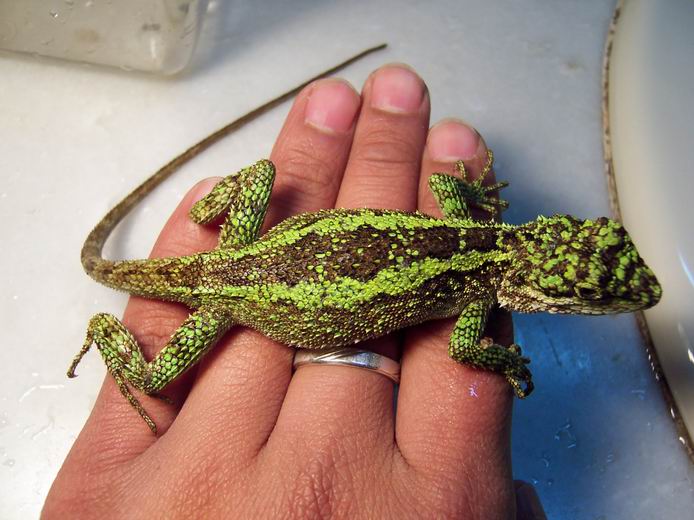(单词翻译:单击)
听力文本
This is Scientific American — 60-Second Science. I'm Karen Hopkin.
Got a minute?
They say that wearing stripes can make you look thinner. Well, lizards don't care about looking svelte. But their stripes might help them avoid getting caught by a hungry predator—and not by camouflage. No, it may be that the stripes make them look like they're moving slower than they really are, messing up the predators' timing. That's according to a report in the journal Royal Society Open Science.
Gopal Murali at the Indian Institute of Science Education Research got interested in the question of why so many lizards sport stripes while perusing hundreds of images of the conspicuously decorated critters.
"Surprisingly when we looked into the literature we did not find any direct experimental evidence for the role of striped coloration in lizards."
Seems such eye-catching coloration would make the bearers easier for predators to spot in the wild. So Murali wondered whether bright stripes might create a sort of optical illusion, one that would disorient predators and maybe get them to grab a lizard's tail rather than a more vital body part.
"Since it is well known that the tail of lizards can be easily lost and most of the predators are known to attack the head or body of lizards, we thought that the purpose of contrasting stripes on the body of lizards in motion might actually trick predators to attack the tail which doesn't cost much for the lizards when its life is at risk."

But does such stripy subterfuge really work that way? To test the idea, Murali could not change the colors of actual animals to see whether racing stripes can really save a lizard's hide, more so than solid colors or random blotches. And he knew he couldn't convince live predators to try to capture fake lizard models. So he did the next best thing.
"We carried out the experiment using humans as surrogate predators and asked them to play a game on a touch screen where they attack the virtual lizards with different color patterns."
Murali had more than 150 volunteers lunge for rectangular prey on a touch screen. He suggested that they aim for the “head”…the region at the front of the rectangle based on which way it was moving. Some rectangles had stripes along their fronts. Others had spots or had stripy bottoms.
Turns out the volunteer predators had a tougher time catching the virtual prey that was striped on top than any of the other variations. And when the hunters made any contact it tended to be at the tail. Because, Murali determined, the effect of the stripes was to make the lizards appear slower than they actually were.
"The findings are analogous to the striped pattern being a force field which prevents predators from attacking the most important body parts and hence redirecting the attacks to the tail."
Leaving more lizards alive, to flee another day.
Thanks for listening Scientific American — 60-Second Science Science. I'm Karen Hopkin.
参考译文
这里是科学美国人——60秒科学。我是凯伦·霍普金。
有一分钟时间吗?
有人说,穿条纹装会让你看上去显瘦。虽然蜥蜴并不在乎看起来苗条这件事。不过它们身上的条纹可以帮助它们避免被饥饿的食肉动物抓住,它们并不是因为伪装才避免被抓的。实际上,因为它们身上的条纹让它们的速度看起来比实际上要慢,导致食肉动物混淆了时间。这份报告刊登在《皇家社会开放科学》。
令印度科学教育研究所的高伯·穆拉里感兴趣的是,为什么大多数蜥蜴会显示出条纹,它为此研究了数百张蜥蜴伪装自己的图片。
“令人惊讶的是,我们在研究资料时,并没有发现有任何直接的实验证据能证明蜥蜴身上条纹颜色的作用。”
看起来这种吸引眼球的颜色会使捕食者更容易在野外发现蜥蜴。所以穆拉里想知道,鲜艳的条纹颜色是否会引起视觉幻象,误导捕食者,让它们抓住蜥蜴的尾巴而不是蜥蜴更重要的身体部分。
“众所周知,蜥蜴的尾巴可以轻易断掉,大多数捕食者都知道要袭击蜥蜴的头部或身体,我们认为蜥蜴让身上出现对比鲜明的条纹的目的是让捕食者产生错觉,去袭击蜥蜴的尾巴,当蜥蜴的生命面临危险时,断掉尾巴对它来说并不算什么。”
但是这种条纹手段真的有用吗?虽然想验证这一想法,但是穆拉里不能通过改变真实动物的颜色,来观察相比于单一的颜色和任意的斑点,条纹是否更能保护蜥蜴的伪装。他知道他不能说服捕食者去捕食假的蜥蜴模型。所以他做了下面这件伟大的事。
“我们让人类作为替代捕食者进行了实验,我们让人们在触摸屏上玩了个游戏,他们要去袭击有不同颜色图案的虚拟蜥蜴。”
穆拉里让150余名志愿者在触摸屏上猛扑长方形的猎物。他让志愿者以猎物的头为目标,以猎物移动方向的前方区域为目标。一些长方形前部有条纹。其他则是斑点或尾部有条纹。
结果是,与其他变化相比,志愿捕食者更难抓到顶部有条纹的虚拟猎物。当捕食者试图接触时,抓住的总是猎物的尾巴。穆拉里认为,这是因为条纹产生的影响会让蜥蜴的速度看起来比实际上要慢。
“这一结果相当于,条纹图案是一种力场,可以阻止捕食者袭击蜥蜴身体上的重要部位,而是让捕食者去袭击蜥蜴的尾巴。”
让更多的蜥蜴活下去,让它们再逃一天吧。
谢谢大家收听科学美国人——60秒科学。我是凯伦·霍普金。
译文为可可英语翻译,未经授权请勿转载!
重点讲解
重点讲解:
1. mess up 干扰;搅乱;
例句:The late arrival of the ship had messed up all our plans.
船到晚了,把我们的计划全打乱了。
2. rather than 而非;胜于;而不是;
例句:The speaker appealed to our emotions rather than to our minds.
演讲者激发了我们的情感而不是启发我们的思考。
3. turn out (以某种方式)发生;最后是;结果是;
例句:They could not have foreseen how things would turn out.
他们不可能预知事情的结果。
4. be analogous to 相似的;类似的;可比拟的;
例句:Marine construction technology like this is very complex, somewhat analogous to trying to build a bridge under water.
像这样的海底建造技术很复杂,与尝试在水下建桥有些相似。


